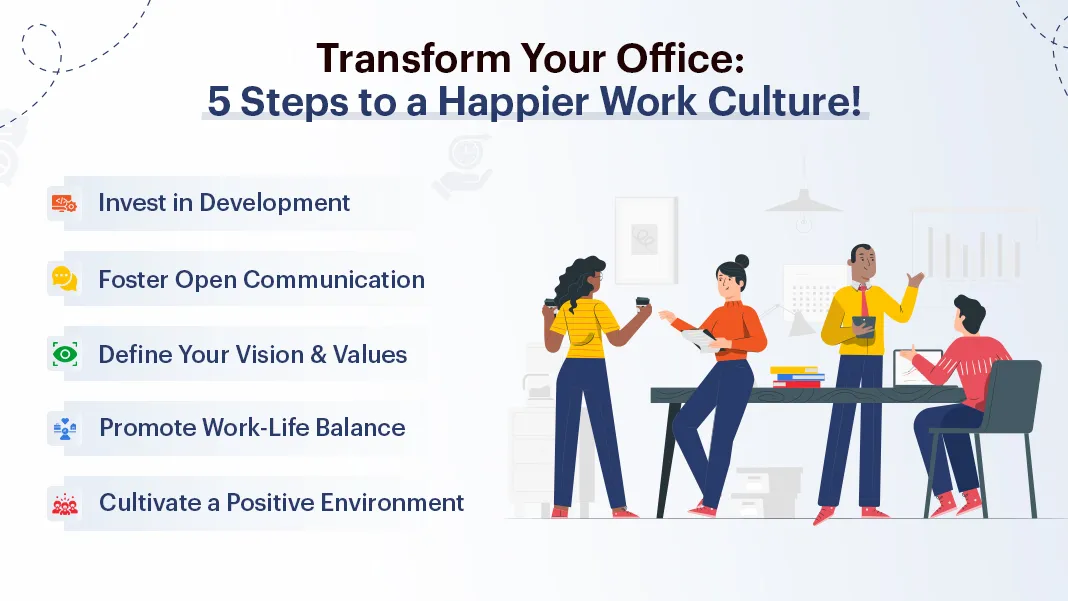If you are a working professional wanting to work in an environment with positive experiences across the board, this blog is just for you if all you are looking for is how you can make your work culture a happy place.
So, to gain more knowledge and understanding, let’s get started directly:
Define & Communicate Your Vision as well as Values
A clear vision and a framework of values establish the foundation of work culture. These form the basis over which your organization behaves, makes decisions, and interacts.
- Establish a Vision Statement: The company should aim to inspire its employees and fulfil its long-term responsibilities. Every level of employment should be involved in this vision and understand its role in bringing us closer to this goal.
- Apart from establishing a vision statement, everyone should identify the core values that align with your company’s mission. These values must include respect, integrity, and collaboration. Ensure both values are more than just words on paper, with leadership doing everything they can to demonstrate them in tangible ways.
- Communicate company values and vision: Do this at every level of your company. Make clear and consistent communication around them so that every employee in the organization knows what they are—and embraces these values—the way they affect basic operations and decision-making.
Foster open and transparent communication.
The cornerstone of a healthy work culture is open communication. It fosters trust and a sense of community for employees because they work together rather than independently.
- Encourage Input: Provide different channels for staff to gather input, including surveys, in-house suggestion boxes, and regular feedback forums. Use this feedback as an opportunity to show them that their voice is important.
- If their performance is persistently challenged and changes, they should be more open and transparent in every leadership opportunity. When the employees know what is going on, they are more passionate and dedicated to doing a successful job.
- Regular Check-Ins: Team managers must and should regularly connect with their colleagues to not only talk about work but also understand what problems they are facing and help them resolve those issues. It is useful since it solves problems before they grow and promotes a nurturing environment.
Invest Properly in Employee Development
If your employees feel they can grow with the company, then more than likely, you have satisfied and engaged team members.
- Staff Training and Development Programs are basically training sessions, workshops, or courses for employees to learn new skills that can enhance their career opportunities. That means ways for them to advance yet still communicate, which shows you are a good business.
Promote Work-Life Balance
Balancing the work and life of every employee is important. As a company, this results in lower stress levels because burnout decreases and job satisfaction improves among those who rebalance the scale.
- Employees are humans and have their private lives, so flexible working hours are also needed. Improve your company’s work-life balance—offer flexible hours or remote options. This makes them better manage their time and reduces stress due to the agility that it provides.
- Encourage a culture of vacation days and discourage a work-to-the-bone mindset. Make sure that employees feel free to take the time they need on their breaks.
- Create Wellness Programs: Wellness programs need to be conducted so that no one gets bored during their working hours. So, conduct these programs and offer happy and healthy times to the employees to make them more productive.
Cultivate a Positive Team Environment
A positive team culture is critical for a satisfied workplace. Employees who are on the same page as their colleagues will be happier workers overall.
- Team Building: Conduct regular team-building activities that can help employees overcome their silos. That can be as casual as a team lunch, an off-site retreat, or a fun challenge.
- An inclusive culture fosters a sense of unity among team members during discussions and decision-making processes. Fuel originality and embrace a culture where a diversity of input is not just welcome but expected; it’s ok when people don’t always agree with each other.
- Conflict Resolution: Resolving conflicts in a timely and fair manner. Train individuals in conflict resolution and communication to enable them to manage disputes.
The Gist
The details show that if you want an amazing and happy workplace, you should follow the above steps and get the best for the space.
However, if you would like further details about the steps, please feel free to contact us immediately. Our team and I would be delighted to assist you by providing guidance in the most effective manner possible.



